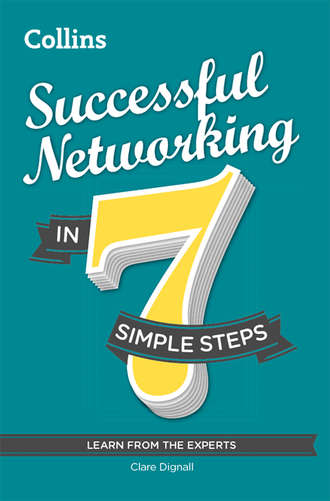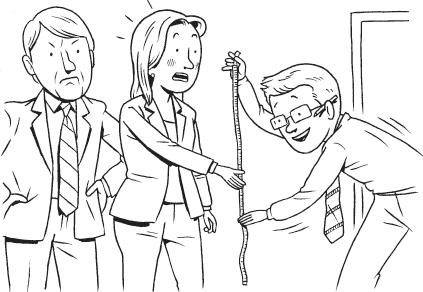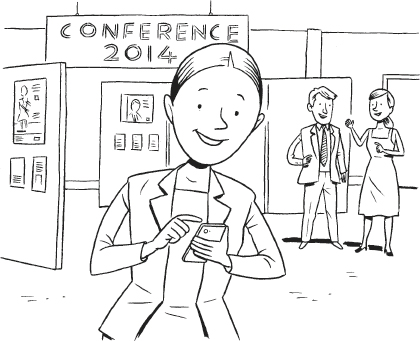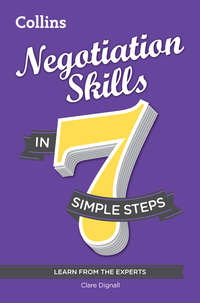
Полная версия
Successful Networking in 7 simple steps


There’s nothing quite like preparation to smooth your way into an event. Many of the following pointers apply to travel anywhere, but never more so than to a network event where it’s imperative you arrive looking cool, calm and collected.
Do you really know where you’re going?
It’s likely that you will attend network events in places you don’t know, and saying ‘I’m sure I will find it okay’ won’t do if you are going to avoid getting lost. On the night before, identify your route on a paper or online map and locate the nearest bus stops, stations or car parks.
Time your travel to the minute
If you want to ensure that you arrive promptly before cliques start to form you must research how long it’s going to take you to get there. Does the event start during the morning or evening rush hour? You’ll need to factor in extra time for travel. Is there public transport or parking nearby? Some posh events may be held in places that are ‘traffic-free’. In such cases you may have to allow time for walking to a venue – possibly with a laptop bag and in new shoes.
Make a checklist and count items in
To save time and effort working out what you need every time you network, create a checklist (business cards, tablet, phone, charger etc.) and attach it to the inside of your bag to literally count those items in and out. Networking conversations can be scuppered before they even start if you’ve left one vital piece of cable or a charger at the office or the previous venue and you’ve no other way to show your products. Forgetting things looks horribly unprofessional and it’s stressful too – don’t put yourself through it.
Check the weather
Travelling from one end of the country to another to network in one day? Check what the weather will be like where you’re going and dress for that, not for where you’re leaving from. Temperatures north to south can differ wildly and you can look foolish if your clothing looks inappropriate for the weather outside. Invest in a compact brolly that can be stashed anywhere too – nothing looks worse than wet hair.
Don’t be above a dress rehearsal
If this event is really important to you, don’t be above doing a dress rehearsal – actually wearing the clothes you plan to wear, actually carrying the laptop bag for two hours, and actually walking from your hotel to the venue to check how long it takes you in new brogues. You may only have to do this a couple of times at the start of your networking ‘career’. But it can be time very well spent.
Key take-aways
Write down the things you will take away from Step 1 and how you will implement them.
Topic Take-away Implementation How to identify your existing network • Who are the people that I already value, whether close to me or just acquaintances? • Check my address book and Facebook friends. How to rediscover your existing network How to identify who your real allies are Learn ways to gain confidence from your existing network How to create new networks The appropriate attitude for networking Practical preparation for events The contents of a business card How to plan networking effectively Tools that will help shape network planning How to become physically prepared for networking eventsStep 2
NETWORK EFFECTIVELY ONLINE
‘Let’s get real about this. Connection is what humans crave.’ — Stephen Fry, Actor, Author, Presenter and Social Media Enthusiast
Five ways to succeed
Check your network’s social media updates every day.
Keep your social media personal profile information up to date.
Maintain your online brand consistently and with integrity.
Customize all default social media invites.
Be mindful of social media law.
Five ways to fail
Prioritize social media over face to face interaction.
Use your personal Facebook page to do business networking.
Post anything, whether business-related or not.
Respond immediately to upsetting social media activity.
Never meet social media contacts face to face.

Networking relies on keeping all your important relationships in a state of health and good repair. It’s a time-consuming activity that needs planning and motivation, especially if your network is a growing one. To help manage large networks while still staying in touch, more and more business people are complementing traditional networking methods with the use of social media such as Facebook, Twitter, LinkedIn® and others. Such sites offer simple ways of keeping in regular touch that take up little time and don’t cost money. They allow you to update your whole network, or a group within it, with what’s new in your world – all in a single action. Such ‘push updates’ can help keep your contacts to feel valued and up to date.

What are the options?
While there are hordes of social networking sites out there to choose from, three could be said to be the ‘big players’ – at least at the moment.
You may be acquainted with Facebook, so we won’t go into any detail. For personal use, Facebook allows you to create your online profile, find and add other users as friends, post photos, send messages and join like-minded groups online. In this arena, its core premise is friendship or shared experience: it’s likely you’ll know, or at least have met, everyone you add as a friend on Facebook. For professional and business use Facebook is a flexible hub for contact details, product or services information, engaging content and interacting with clients. See www.facebook.com.
LinkedIn®
Presence on LinkedIn® is increasingly seen as a ‘must-have’ in the world of business. Users create a personal profile including their curriculum vitae, key skills and expertise, detailed work experience and more. Literally designed to extend and enhance the process of networking, registered users can invite anyone with whom they have some level of professional relationship to become a ‘connection’, effectively providing the user with a database of contacts and their specialist knowledge. Business people use it to stay in touch, stay abreast of the job market, or seek work. Employers use it to list jobs, search for, and check out potential candidates. By showing the user the connections of their connections, LinkedIn® also demonstrates opportunities for introductions through mutual contacts. See www.linkedin.com.
Twitter is a social networking service whose core premise is that of ‘micro-blogging’, where users post and read messages or ‘Tweets’ of 140 characters or less. To receive Tweets, you must follow people or groups that interest you, whether they be friends, celebrities, brands, columnists, newspapers – or interesting strangers. Tweets are presented in a timeline, creating a concise and immediate digest of what’s happening in the world that interests you. Unlike Facebook, there’s no assumption that you need to know someone before following them. It is acceptable to follow, say, a celebrity, and open dialogue with them by replying to their Tweets. It is perhaps this lure of instant access to high-profile people that has been central to the ever-increasing popularity of Twitter. If you follow someone and they then choose to follow you, a further layer of communication is offered in the form of ‘direct messaging’ or the ‘DM’. These Tweets are not public, but can be exchanged between two parties who follow each other in addition to default public Tweets. See www.twitter.com.
What are their intended audiences?
LinkedIn® is strictly professional – the work-life you, always at your best; Facebook, though most used for personal updates, is increasingly being harnessed by people to profile their business or profession entirely distinct from their personal Facebook account. Twitter can be used judiciously to post updates that may appeal to both personal and professional contacts – you could think of it as ‘first-date you’ – the whole story, but at its best.

We’ve identified the options, but what, in real terms, do you ‘do’ with social media? What functions can they carry out to enhance and extend your face to face networking?
How should I use them?
Looking at some key areas of social media sites will get you started, allowing you to learn more on the way.
Review your profile: On sites where your employment information, work and skills are displayed, such as LinkedIn®, ensure they’re correct. Ensure that your profile is complete, proofed, and bang up to date.
Check what your contacts are doing: Your daily routine should include checking what your contacts are doing via their status updates and posts on Facebook, LinkedIn® or Twitter etc. Use this information to help initiate and personalise your contact with them. So, for example, you may congratulate someone within LinkedIn® for their new job status update, or, contrastingly, email a contact after seeing their Tweet about an event they’d attended. Opening with ‘Hi, I saw your Tweet about the London event – it sounded great!’ gives you an excuse for getting in touch, and shows you’re taking long-term interest.
Post regular updates: Known informally as ‘pinging’, posting regular updates to LinkedIn®, Twitter and Facebook helps keep you in the front of many people’s minds. Share information and articles through these platforms to offer value to your contacts in an efficient manner. Pinging allows others to passively digest what’s going on in your life and what your hopes are. From your posts they’ll build a picture of your goals and aspirations. If they want to respond, they can and will.
Ask or answer questions: People like answering a question authoritatively: if you want a reaction from your social media network, ask a question! LinkedIn® has an answers feature where you can both ask and answer questions, giving you the opportunity to demonstrate your curiosity about business and showcase your knowledge to an interested audience.
Post comments or likes: Make personal contact quickly by commenting on someone’s status on Facebook or LinkedIn®. If you are pushed for time, even hitting ‘like’ or re-Tweeting will bring your name to the front of someone’s mind briefly, making them feel good about the fact you noticed.
Endorse: LinkedIn’s® endorsement function allows you to attest to a contact’s skills and expertise. Use this feature only to authenticate skills that are proven. By endorsing judiciously, everyone wins. Your contact builds a strong and verified skills profile, you give them a useful and appropriate ‘gift’, and everyone feels good about the transaction. Most people you endorse will also reciprocate in their own time.
Social media and privacy
Making social media work for, not against you, relies on having a strong awareness at all times of what you want people to see and what you don’t.
Facebook and privacy
If you’re starting your own business, create a Facebook page for the business itself, entirely removed from your own page on Facebook. Then you can maintain two discrete accounts, promoting your professional image on your business page, while keeping your off-duty presence (and friends) private on your personal account. Keep these parts of your life separate – you don’t want clients to see you in a compromising snap. Furthermore, if and when you do create a Facebook account for your business or profession, check that your personal account is then private, meaning access to your photos and information is only available to those you’ve carefully accepted as friends. Bear in mind that some big companies now block the use of Facebook by staff – even remote staff. If Facebook is your main medium for social media business promotion, ensure that companies you hope to work with are keen on using Facebook.
Because you will aim to have followers on Twitter who are both personal and professional contacts, be careful what you write. Be positive. Never swear. If you are having a bad day, don’t Tweet about it. Negativity and cynicism can be a turn-off, and criticism of others can be dangerous. Read on for more information on social media and the law.

What makes a brand? Perhaps an important element is consistency: a strong brand creates clear associations in our minds. Stop anyone in the street and they could probably describe the core values of Coca Cola, Sony or Apple in a few words, and those very words would resemble those chosen by other people. But people are brands too. Consider celebrities: the more successful they are, the more they embody one core persona. You expect them to look and behave in a certain way. We feel comfortable when people are consistent, and harnessing this simple human preference for consistency can be a powerful tool in successful networking. We’ve seen in the preceding Steps that your face-to-face brand is extremely important, and you’ve been working hard to develop it. You also need to do the same with your online presence.
To take networking seriously you may have to work on your online brand; the brand that is you. ‘Google’ yourself on the Internet – it can be an eye opener. This is what a new contact could find if they wanted to do some background research on you. It’s up to you to start creating the picture you want to present: professional, positive and consistent.
Building your online brand
Creating an online brand sounds complicated, but it isn’t: it’s simply the process of ensuring that what people can find about you online is consistent with, and underlines, the persona you’ve worked hard to develop face to face. It’s checking that everything hangs together, and creates a holistic picture of someone trustworthy and professional.
Act on your Google results: Did you see anything up there that you wouldn’t want potential clients to see? If they’re within your control, take them down or lock them down to friends only. Negotiate with friends who’ve posted embarrassing snaps or posts about you. Use your judgement – everyone relaxes on holidays and nights out, so don’t become too obsessive. But if you’re portrayed breaking the law, bending rules, or playing hookie from work, remove this material.
Think of your social media as a suite: Scrutinize your LinkedIn® profile and posts, your Tweets, your Facebook activity, and your blog if you have one. Each of these media serve different purposes with different levels of formality, but underneath that, do you hear a core, consistent voice running through them? If not, you may need to spend more time considering how you want to come across, and keep this in the front of your mind every time you post, re-Tweet or upload. We’ll look at this in detail next.
Конец ознакомительного фрагмента.
Текст предоставлен ООО «ЛитРес».
Прочитайте эту книгу целиком, купив полную легальную версию на ЛитРес.
Безопасно оплатить книгу можно банковской картой Visa, MasterCard, Maestro, со счета мобильного телефона, с платежного терминала, в салоне МТС или Связной, через PayPal, WebMoney, Яндекс.Деньги, QIWI Кошелек, бонусными картами или другим удобным Вам способом.



